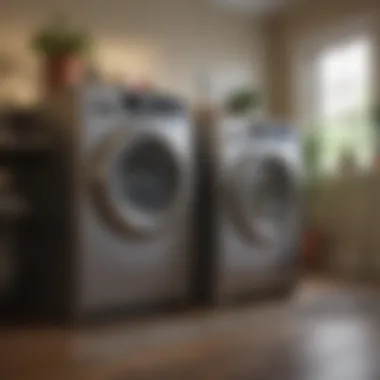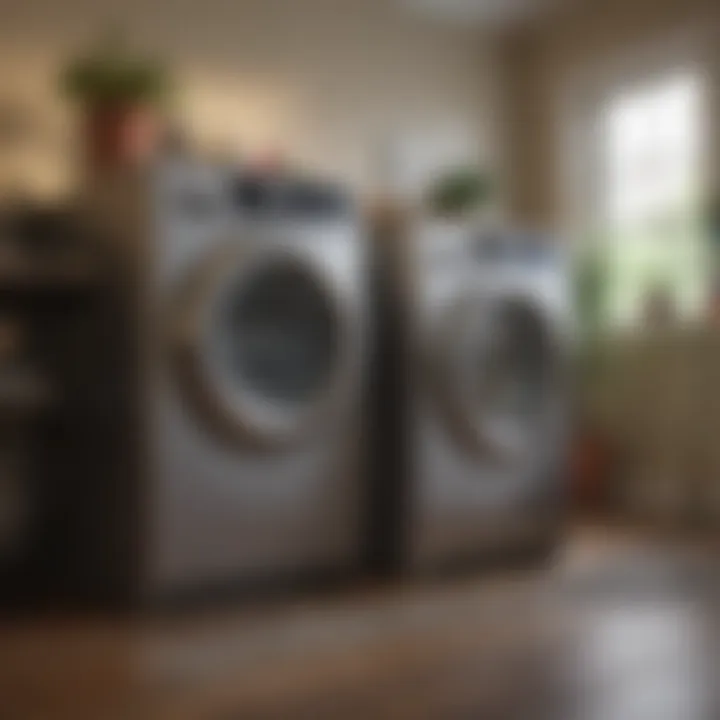Smart Ways to Cut Down Household Energy Use


Overview of the Topic
Reducing household electricity consumption has become vital in today’s energy-conscious world. With utility bills on the rise and environmental concerns taking center stage, understanding how to effectively manage energy use is not just a luxury—it's a necessity. The topic encompasses a wide array of methods and techniques, ranging from straightforward behavioral changes to the integration of advanced technologies.
Importance: Practicing efficient energy consumption at home has implications beyond just cost savings. It helps in minimizing the carbon footprint, leading to a more sustainable lifestyle and a healthier planet. Furthermore, with resources becoming scarcer, employing measures to reduce electricity use ensures we can preserve these resources for future generations.
Key Benefits:
- Cost Savings: One of the most immediate advantages of reducing energy consumption is lower utility bills.
- Environmental Impact: Less energy use typically means lower greenhouse gas emissions, thus benefitting the environment.
- Enhanced Comfort: Striving for energy efficiency often leads to improved home comfort and reliability in energy usage.
- Property Value: Homes that are energy-efficient can have higher market value, appealing to environmentally conscious buyers.
"Being energy-wise isn’t just smart financially; it’s a step towards a sustainable future."
Exploring Strategies and Tips
To tackle energy consumption effectively, it's crucial to adopt specific strategies tailored to individual household needs. Here are a few avenues worth exploring:
- Conduct an Energy Audit: This can be done using online tools or through professional services. Identifying the largest energy drains in your home is critical in formulating a plan.
- Upgrade to Energy-Efficient Appliances: Consider replacing old devices, such as refrigerators and washing machines, with Energy Star-rated models. They consume significantly less power without sacrificing performance.
- Adjust Daily Habits: Small shifts in daily routines can lead to profound changes, like turning off lights when exiting a room or unplugging chargers when not in use.
- Leverage Smart Technology: Systems such as smart thermostats and smart plugs not only offer convenience but also help monitor and reduce energy usage.
Strategies for Effective Management
- Set a Monthly Budget: Aligning your household budget with planned energy expenditures encourages mindful consumption.
- Regular Maintenance: Ensure heating and cooling systems are serviced yearly to maintain efficiency.
- Utilize Renewable Energy: If feasible, consider solar panels or other types of renewable energy sources to help mitigate reliance on grid electricity.
Case Studies and Examples
Real-life scenarios help illuminate the impact and practicality of these strategies:
- The Smith Family: After conducting an energy audit, the Smiths discovered that their aging refrigerator was responsible for 50% of their electric bill. Replacing it with an Energy Star model reduced their overall consumption by 30%.
- Community Initiatives: In a neighborhood initiative, several households opted for a group solar panel installation. Not only did they benefit from bulk discounts, but their collective energy savings were substantial.
Pitfalls to Avoid
- Over-commitment: Many families set ambitious goals to cut electricity. However, failing to meet these can lead to frustration. It’s more beneficial to start small and gradually ramp up efforts.
- Ignoring Habits: Focusing solely on technology or appliances without adjusting daily habits may lead to limited changes in consumption.
Expert Insights and Recommendations
Experts in energy management advocate for a blended approach of behavioral and technological methods.
- Dynamic Pricing Awareness: Understanding the fluctuating rates of energy during peak and off-peak hours can help better manage electricity usage. Strategically running appliances during lower-cost periods can lead to substantial savings.
- Participation in Energy Programs: Many local utilities offer programs that reward customers for reducing consumption during peak times. Signing up can foster energy-saving habits while providing financial incentives.
Understanding Electricity Consumption
Understanding household electricity consumption is crucial as it sheds light on how energy is used in daily life. The significance of this topic is not limited just to saving money; it reaches far deeper into sustainability and efficiency. By knowing where and how energy is consumed, homeowners can make informed choices that lead to reduced bills and a smaller environmental footprint.
Overview of Household Energy Use
Every home operates on a unique energy profile, with the average household consuming a considerable amount of electricity each month. This usage often varies depending on various factors such as the size of the home, the number of inhabitants, and the presence of energy-hungry appliances. On average, typical household electricity consumption might be around 877 kWh per month in the United States
Given these figures, one can see why understanding this landscape is vital. Identifying specific energy consumption patterns can help in prioritizing changes that have the potential for maximum impact. For instance, large appliances like refrigerators and air conditioners generally account for a significant chunk of the electric bill.
Factors Influencing Energy Costs
Several factors play a role in determining energy costs for households. For one, utility rates vary by region. Areas with high demand during peak seasons can experience elevated rates. Additionally, the age and efficiency of appliances contribute to energy expenditures. Older models often consume more electricity per use compared to their newer, energy-efficient counterparts.
Furthermore, local weather can also be a significant influencer. In colder climates, heating costs can skyrocket during winter months, while those in warmer regions face higher costs from cooling. Economic factors, such as inflation and changes in energy policy, can also affect electricity prices. Understanding these nuances can empower homeowners to identify when and how to adjust their consumption habits effectively.
Importance of Reducing Energy Consumption
Reducing energy consumption goes beyond financial savings; it bears significant implications for the environment too. The connection between energy use and environmental health is clear. Lowering electricity consumption helps reduce greenhouse gas emissions, as less electricity generally translates into reduced fossil fuel burning for energy generation.
Moreover, conservation leads to less strain on power grids and helps in enhancing energy security. Consequently, energy savings can contribute to stabilizing or lowering utility rates over time, creating a beneficial feedback loop. Therefore, taking steps to reduce energy consumption can result in immediate benefits for both the individual homeowner and the larger community.
"Every little bit counts; small changes in household energy use can lead to significant overall benefits."
Behavioral Adjustments to Save Electricity
Making behavioral adjustments is one of the most straightforward and effective ways to cut down on household electricity usage. Often, people overlook simple changes in their daily habits that can lead to substantial energy savings. By being more conscious about how we use energy, not only can we reduce costs, but we can also contribute to environmental sustainability.
Consider the everyday actions that homeowners often do without thinking. For instance, leaving lights on in unoccupied rooms is a habit many practice. If everyone made it a point to turn off lights when they leave a room, the collective impact could be profound. These small steps are foundational to developing a culture of energy efficiency within the home.
Smart Usage of Appliances
Appliances are a significant source of household energy consumption. To use them wisely involves more than just flipping a switch. First and foremost, checking the usage settings can make a marked difference. Many appliances have energy-saving modes which, contrary to popular belief, do not compromise performance. For example, using the eco-cycle on a washing machine not only saves electricity but also uses less water.
Moreover, timing is everything. Using high-energy appliances during off-peak hours—usually at night or early morning—can lead to lower utility bills.
- Key Tips:
- Use appliances during off-peak hours
- Engage energy-saving modes
- Regularly clean and maintain appliances to ensure they run efficiently


Mindful Lighting Practices
The lighting in our homes doesn’t need to be a large expense if approached thoughtfully. Switching from traditional incandescent bulbs to LED options can yield significantly lower energy bills. Not only do LEDs consume less energy, but they also have a longer lifespan, reducing the need for frequent replacements.
In addition, utilizing natural daylight can reduce reliance on artificial lighting. Arrange furniture to make the most of sunlight, reducing the time you rely on electric lights.
"A significant chunk of residential energy is tied to lighting. Being aware can make a major difference to your monthly bill."
Adjusting Thermostat Settings
Being aware of thermostat settings is crucial. A home can feel significantly different with a minor adjustment in temperature. For instance, during winter, setting the thermostat just two degrees lower can lead to notable energy savings over time. The same principle applies in summer—keeping the thermostat a few degrees higher can ensure comfort without overworking the HVAC systems.
Using programmable thermostats can also help. These devices allow homeowners to set schedules based on their daily routines, so the system runs only when needed.
Optimizing Water Heating
Water heating might not be the first thing that comes to mind when reducing electricity usage, but it can be a notable contributor. Many homes have water heaters set to higher temperatures than necessary, leading to higher energy costs. Ideally, setting the water heater temperature to around 120°F (49°C) can efficiently provide hot water while saving energy.
Additionally, insulating the water heater and pipes can minimize heat loss, further improving energy efficiency.
Implementing these behavioral adjustments can go a long way toward more energy-efficient households. Generally, these changes do no require large investments, yet the savings can really add up over time. The simple act of being intentional about energy use lays the groundwork for a sustainable future.
Technological Innovations for Energy Savings
Technological advancements are revolutionizing how we manage energy consumption at home. The impact is not only felt in our monthly utility bills but also in the broader context of environmental sustainability. By investing in modern technologies, homeowners can significantly reduce their energy use, making this an important topic in our exploration of effective electricity-saving strategies. Such innovations provide not just tools, but opportunities for a lifestyle change toward energy efficiency.
Smart Home Technology
Innovative smart home technology is at the forefront of the movement to reduce electricity consumption. These systems streamline management of household devices, allowing homeowners to monitor and control energy use remotely. The convenience alone is compelling, but the real benefit lies in their efficiency.
Home Automation Systems
Home automation systems are crucial within smart technology. This specifically refers to integrated solutions that allow various home devices to communicate with each other and function cohesively. One key characteristic of these systems is remote accessibility; users can control lights, thermostats, and appliances through their smartphones or other devices. This flexibility makes them a popular choice among homeowners aiming to save energy.
A unique feature of home automation systems is scheduling capabilities. For instance, you can program your heating to turn down at night or your lights to turn off when you leave the house. Advantages of this include not just energy savings, but also enhanced comfort and convenience. However, initial setup costs can be high, posing an obstacle for some.
Energy Monitoring Devices
Energy monitoring devices have emerged as a significant aspect of smart technology. They track energy consumption in real-time, helping households identify energy hogs. The primary characteristic of these devices is their capacity for detailed reporting on usage patterns, which equips users to make informed decisions about energy efficiency.
A vital feature of energy monitors is their analytics software. This goes beyond simple data collection; it provides insights into usage trends and can even suggest ways to conserve energy. The advantages include not just potential cost savings but also increased awareness about household energy consumption. However, some users might find interpreting the data challenging, which can limit effectiveness.
Energy-Efficient Appliances
Energy-efficient appliances represent a leap in innovation aimed at reducing energy consumption. These appliances are designed to use less electricity while still delivering similar or improved performance compared to standard models. The key characteristic here is their design - often utilizing advanced technology such as variable-speed motors or improved insulation to achieve efficiency.
A unique feature of many energy-efficient appliances is their Energy Star certification, which signals compliance with strict standards set by the Environmental Protection Agency. This provides assurance that the product meets high efficiency benchmarks. The advantages of choosing these appliances are two-fold: lower energy bills and reduced environmental impact. Yet, the upfront investment might be a drawback for some homeowners, particularly those on a tight budget.
LED Lighting Solutions
Switching to LED lighting solutions can represent a significant reduction in electricity use for households. LED bulbs utilize considerably less energy than traditional incandescent ones while providing the same, if not better, brightness. The standout feature of LED lights is their lifespan; they can last up to 25,000 hours—which is a dramatic improvement over standard bulbs.
The advantages of LED lighting extend beyond just consumption. They emit less heat, contributing to better energy efficiency, especially in warmer climates where traditional lighting may increase cooling costs. However, the higher initial purchase price compared to incandescent bulbs may deter some householders, even though the long-term savings generally outweigh this.
Solar Power Options
Solar power options offer a renewable source of energy that can dramatically cut down household electricity bills. By harnessing sunlight, homeowners can produce their own power, particularly appealing in locations with ample sunny days. The key characteristic of solar power systems is their ability to generate electricity with minimal ongoing costs once installed.
One of the unique features of many solar power systems is the possibility of net metering. This allows homeowners to sell excess electricity back to the grid, further enhancing savings. Additionally, installing solar panels can increase property value, making this an attractive option despite the often sizable initial investment. Nonetheless, prospective buyers must consider the installation process and regulatory implications that can differ widely depending on local laws and regulations.
Home Design and Layout for Efficiency
When it comes to saving electricity at home, the design and layout of your living space play an unsung, but vital role. The architecture and spatial arrangement of your home can either siphon up energy or help in conserving it. Energy efficiency isn't solely reliant on technologies or appliances, but also how the home itself is structured. Let’s delve deeper into specific aspects of home design that promote electricity savings.
Insulation and Air Sealing
One of the cornerstones of energy efficiency is having proper insulation and air sealing in your home. Good insulation creates a barrier that helps maintain indoor temperatures, which ultimately reduces the work your heating or cooling systems have to do. Think of insulation as a thick sweater that keeps the warmth in during winter and the coolness in during summer. Ensure that your walls, attic, and floors are well-insulated using materials like fiberglass, foam board, or spray foam.
Sealing those drafts around windows and doors is equally crucial. Even small gaps may seem harmless, but they can lead to considerable energy loss over time. Consider using caulk or weatherstripping to seal any leaks around openings. This attention to detail can save you a good chunk on your energy bill, not to mention keep your home cozy year-round.
Window Placement and Treatment
The placement of windows can make or break your home’s energy efficiency. A strategically placed window can harness sunlight effectively, ensuring you don’t need to flick a switch for light during the day. For example, consider larger windows facing south to capture as much sunlight as possible. Not only does this illuminate your space, but it also reduces the need for artificial lighting.
However, let’s not forget about treatments. Using blinds or curtains can help regulate the amount of heat that enters or escapes through your windows. During summer months, keep those heavy drapes drawn to block out the sun, and in winter, allow sunlight to warm your home.
Utilizing Natural Light
Speaking of sunlight, maximizing its use is a smart strategy towards energy efficiency. Natural light is an amazing resource, free and abundant during the day. Designing your space with an open floor plan can help light flow through your home.


Consider incorporating skylights or light tubes in darker areas of your home, such as hallways or bathrooms. They can bring in plenty of sunlight without consuming any electricity. Balancing between light and shade can create a healthier indoor environment, and, ultimately, a lower electricity bill.
Designing your home with an eye toward maximizing energy efficiency isn’t merely about aesthetics; it’s about creating a sustainable living environment where electricity is used wisely. Each detail adds up, providing you with advantages that ripple through your energy bills and ultimately, your lifestyle.
Monitoring and Adjusting Energy Use
Effective management of household energy consumption hinges on the ability to monitor and adjust usage patterns. This aspect allows homeowners to not only take stock of their current electricity consumption but also to identify areas where significant savings can be achieved. Monitoring brings visibility to patterns that often go unnoticed, while adjustments help align energy use with actual needs and behaviors.
Utilizing Energy Audits
Energy audits serve as a cornerstone for understanding where energy is being consumed in a home. These audits can be conducted by professionals or through DIY approaches that involve checking for energy inefficiencies. Residents can analyze each concept from lighting to appliances. Key areas of focus include:
- Insulation gaps that lead to heat loss.
- Old appliances that consume more energy than newer, more efficient models.
- Leaky windows or doors that affect air quality and temperature regulation.
Contracting a professional can yield an expert analysis. Alternatively, an in-depth self-audit can be done by assessing energy bills and identifying usage spikes. Auditing, altogether, not only reveals consumption habits but also highlights the most pressing opportunities for improvement.
Setting Up Energy Tracking Systems
The establishment of energy tracking systems offers a proactive approach toward energy management. These systems can range from simple spreadsheets to sophisticated smart meters that track consumption in real-time. With such tools in place, users can:
- Monitor energy use on a daily basis.
- Identify spikes or unusual consumption patterns.
- Set budget goals for each month.
These customized tracking systems are essential for cultivating a mindset geared towards energy saving. When you see real-time data, it’s much harder to ignore those practices that rack up significant costs over time, like leaving the lights on when it's not needed or overusing heating and cooling systems.
Creating an Energy-Saving Plan
An energy-saving plan is essential for translating insights gleaned from energy audits and tracking into actionable strategies. This plan should encompass both short-term and long-term goals tailored to individual household needs. Consider the following steps:
- Evaluate results from energy audits to pinpoint critical areas for improvement.
- Set clear energy reduction goals—perhaps aim for a 10% reduction in the next year.
- Incorporate sustainable practices—like switching to LED bulbs or scheduling thermostat adjustments based on outside temperatures.
- Review the plan regularly and adjust goals as necessary, based on each month’s energy tracking data.
Establishing a systematic plan arms households with a roadmap leading to significant energy savings while fostering a culture of sustainability amongst family members.
"Tracking and planning are the keys to unlocking potential savings. Consistency is crucial; small changes can lead to monumental outcomes over time."
By highlighting monitoring and adjusting energy use, determining specific practices like conducting energy audits, implementing tracking systems, and crafting an energy-saving plan, households are better positioned to take charge of their electricity consumption. Not only does this empower residents to slash their bills, but it also contributes positively to larger environmental goals.
The Economic Impact of Energy Savings
When we talk about reducing household electricity consumption, we often focus on methods to cut down usage. However, the economic implications of these strategies play a critical role. Saving energy isn't only about being eco-friendly; it can lead to substantial savings on utility bills and even impact the overall value of your home.
The alignment of financial prudence with energy conservation opens doors to a world of benefits, not merely for the wallet but also for budget-conscious planning in today’s stringent economic climate.
Calculating Cost Savings
Understanding how much you can save is the first step down this road. Households can start by evaluating their monthly electricity bills. It’s wise to compare these expenses over several months to get a more accurate figure. Add up the total annual expense and identify areas for reduction. For instance, if you usually spend $1,200 a year, small changes might help trim this by 20%.
Some practical tips to find potential savings include:
- Energy-efficient Appliances: Replacing old appliances with ENERGY STAR-rated ones can bring down electricity use considerably.
- Lighting Changes: Swapping traditional bulbs for LED lights can dramatically cut energy costs, providing savings that add up over time.
- Reducing Standby Power: Many devices consume energy even when turned off. Unplugging devices or using smart strips to eliminate phantom loads can significantly decrease bills.
Understanding Return on Investment
When contemplating methods to cut energy costs, it’s essential to measure return on investment (ROI). This involves calculating the time taken to recover costs from an energy-saving improvement. Sometimes, an upfront expense can appear daunting, but many actions pay for themselves quickly.
To illustrate: if you purchase an LED bulb for $10 that lasts 25,000 hours while a regular bulb costs $2 and lasts only 1,000 hours, you’ll save not only on the initial cost but on the long-term energy consumed.
To assess ROI, consider:
- Initial Cost vs. Savings: Calculate the potential savings each month after switch is made.
- Payback Period: Determine how long it will take to recoup the expense through reduced bills.
- Long-term Gains: Factor in extended lifespan and durability of energy-efficient options that traditional models can't match.
Government Incentives and Rebates
Aside from personal savings, the government often steps in to encourage households to adopt energy-efficient practices. Many states offer incentives, grants, and rebates to help soften the financial blow of upgrades. These initiatives can range from tax credits for solar energy installations to direct rebate programs for energy-efficient appliances.
Here are a few notable benefits:
- Lowered Upfront Costs: Incentives manage to shrink the initial expenditure, making your decision to invest in energy savings less daunting.
- Increased Property Value: Homes equipped with green technology often command higher market prices, making them a worthy investment for the long run.
- Community Programs: Some local governments also have programs to help with financial planning or offer resources for energy audits, enabling households to seek advice tailored to their specific situation.
Investing in energy efficiency is not merely an eco-conscious trend but a systematic approach to enhancing financial well-being.
In summary, the economic impact of energy savings is multifaceted, influencing direct cash flow, property value, and even the broader market. Whether through calculating potential cost savings, evaluating ROI, or taking advantage of government incentives, homeowners can transform their approach to energy consumption into a powerful avenue for financial improvement.
Environmental Considerations
Considering the environmental effects of electricity consumption is essential when exploring strategies to reduce energy use. Each time you flick a switch to power something, you're not just altering an electric meter. You're also engaging in a relationship with the environment. This relationship has implications for air quality, wildlife, and the Earth's overall health. Reducing electricity demand isn't only about saving on bills; it deeply correlates with protecting our natural ecosystems.
Impact of Electricity Generation on the Environment
Electricity generation predominantly relies on fossil fuels like coal, oil, and natural gas, which emit greenhouse gases and other pollutants when burned. These emissions contribute to global warming, smog formation, and acid rain, all of which harm not only human health but also biodiversity. Each kilowatt-hour generated leaves a footprint, so by decreasing your consumption, you're directly lessening the demand for these harmful energy sources.


For instance, think about the vast areas deforested for coal mining or oil drilling in delicate ecosystems. By opting for energy-saving measures at home, individual households can lessen their contribution to these destructive practices. Consequently, you are not only saving energy but also protecting wildlife habitats and ensuring cleaner air for future generations.
Reducing Carbon Footprint
Your carbon footprint is essentially the total amount of greenhouse gases emitted directly and indirectly through your activities. It's not just an abstract number but a direct measure of one's impact on climate change. When households embrace energy-efficient practices—like using LEDs instead of incandescent bulbs, or unplugging devices when not in use—they can significantly reduce their carbon footprint.
- Additional Benefits of Reducing Carbon Footprint:
- Healthier Air Quality: Fewer emissions mean fewer respiratory issues caused by polluted air.
- Contributing to a Sustainable Future: Each step toward energy efficiency helps combat climate change, promoting long-term ecological balance.
Thus, making those small adjustments in your energy consumption truly adds up, enhancing not just the immediate environment but also bolstering efforts against global warming.
Sustainable Energy Alternatives
The rise of sustainable energy alternatives presents a pathway to lessen our dependency on non-renewable resources. Solar, wind, and hydroelectricity are not just buzzwords; they represent the future we should strive toward. These sources produce energy without the harmful emissions associated with fossil fuels and have much lower environmental impacts.
- Solar Power: Harnessing sunlight is becoming more practical for many homes. Solar panels can drastically reduce your reliance on grid power.
- Wind Energy: Community wind farms can be another viable alternative, empowering residents to tap into wind resources.
- Hydropower: Though it has some ecological considerations, properly managed hydroelectric plants can provide consistent energy without direct emissions.
By embracing these sustainable options, households can transform their consumption footprint and take on a proactive role in supporting a cleaner planet.
Combining these efforts isn't just an altruistic endeavor; it’s also economically sound. The cost savings from reduced energy bills and potential income from selling excess energy back to the grid can be considerable.
Challenges in Reducing Electricity Consumption
In our quest for energy efficiency, we often encounter numerous obstacles that can have a significant impact on our efforts to reduce household electricity usage. Addressing these challenges is not merely an exercise in frustration but rather a vital part of the conversation that shapes how we approach energy consumption in our homes. By recognizing and understanding these hurdles, we can strategize effectively, paving the path toward lower bills and a smaller ecological footprint.
Overcoming Behavioral Barriers
Behavioral barriers are often the most daunting part of our journey to lower energy use. Many of us are deeply ingrained in habits that contribute to higher energy consumption. It can be a matter of convenience; after all, it's easier to keep the lights on in every room than to flip switches.
To break these habits, homeowners need to cultivate a culture of mindfulness around energy use. Simple nudges can make a big difference—for instance:
- Using stickers on light switches to remind family members to turn off lights when they leave a room.
- Incorporating energy challenges among family members or roommates, turning saving energy into a fun competition.
- Establishing routines that tie energy-efficient practices to daily activities, like setting reminders to unplug devices before bed.
While it may feel like a slog at the start, tweaking our daily behaviors can lead to remarkable long-term savings.
Initial Costs of Upgrades
When considering upgrades to more energy-efficient appliances or systems, upfront costs can be a significant sticking point for many homeowners. High-efficiency washers, smart thermostats, or better insulation might seem like a costly venture at first glance.
However, it’s crucial to frame these expenses as investments rather than mere costs. To help ease the financial burden:
- Investigate rebates or tax credits offered by local governments or energy companies for purchasing energy-efficient appliances.
- Perform a cost-benefit analysis, comparing the long-term savings from reduced energy bills against the initial outlay.
- Consider second-hand options for appliances, which can significantly cut down on expenses while still improving efficiency.
Recognizing that initial costs can pale in comparison to the cumulative savings over time shifts the perspective from simply spending to making an astute financial decision.
Adapting to New Technologies
The landscape of household technology is evolving at breakneck speed, and while this can be exhilarating, it also presents another hurdle in energy consumption reduction. New technologies often come with a learning curve that can deter some users, particularly if they're accustomed to traditional methods.
To facilitate adaptation, homeowners can:
- Attend workshops or local classes that focus on new energy-efficient technologies.
- Seek guidance from neighbors or community members who have already made the leap into smart home setups.
- Leverage online resources like forums or social media groups to ask questions and gather insights on making transitions easier.
Though the shift to new technologies might feel overwhelming at first, embracing them can lead to impressive improvements in energy management.
"Innovation is the fuel for our progress, and understanding its implementation makes all the difference in home energy management."
Looking Ahead: The Future of Energy Efficiency
As we venture further into the 21st century, the importance of energy efficiency continues to gain momentum. The future is not just about conserving electricity; it’s a commitment to sustainable living and economic resilience. Energy efficiency can improve our quality of life, providing us with more affordable utility bills and creating a cleaner environment. The influx of new technologies and shifts in regulations all signal that the energy landscape is changing rapidly, leaving homeowners with a unique opportunity to adapt and thrive.
Emerging Technologies and Trends
The horizon is brimming with innovations aimed at optimizing how we consume energy in our households. One such trend is smart technology, allowing homeowners to manage their energy usage closely. Devices like smart thermostats learn your schedule and adjust temperature settings intuitively, ensuring comfort while saving electricity. On the lighting front, motion sensors and smart bulbs not only reduce energy waste but dynamically adapt to natural light availability, further cutting into unnecessary consumption.
In addition to these, advancements in energy storage technologies are paving the way for more sustainable energy use. Home batteries, like those from Tesla and LG Chem, empower individuals to store excess energy produced by solar panels. This shift enables homeowners to utilize more of their generated energy throughout the day and reduce reliance on grid power, which often comes from less sustainable sources.
Policy Changes and Their Implications
At the community and governmental levels, policies are continuously evolving to promote energy efficiency. A notable trend is the introduction of stricter building codes requiring higher energy standards for new constructions. These regulations are designed with the environment in mind, pushing for enhanced insulation, energy-efficient windows, and HVAC systems that consume less electricity.
Moreover, incentives for homeowners adopting energy-efficient practices are emerging. Tax credits, rebates, and other financial incentives support the purchase of energy-efficient appliances and home retrofits, making it an economically sound decision for homeowners looking to upgrade. These changes not only bolster individual savings but also contribute to a larger movement aimed at reducing carbon emissions on a national scale.
“In many cases, investing in energy efficiency pays for itself through savings on utility bills, while also boosting property values and sustainability.”
Community Initiatives for Energy Conservation
Communities play a pivotal role in the journey towards energy efficiency. Initiatives that bring residents together can magnify the impact of energy-saving efforts. Neighborhoods can organize energy challenges, encouraging families to monitor and reduce their electricity use as a collective. Such competitions not only foster camaraderie but also raise awareness surrounding consumption habits.
Local governments often launch campaigns aimed at educating residents about energy conservation. Workshops, public meetings, and online resources assist homeowners in implementing energy-saving strategies, connecting them with experts in home energy audits or providing information on available subsidies.
Further, community solar programs allow multiple homeowners to invest in a shared solar project. These collaborations broaden access to renewable energy options, ensuring that even those without suitable roofs can benefit from solar power, ultimately reducing dependence on conventional electricity sources.
The integration of these local initiatives highlights a broader understanding that individual efforts combined can lead to substantial changes in energy consumption patterns.



